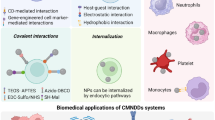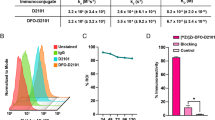Abstract
Purpose
DNA aptamer (APT) is able to bind to Mucin 1 (MUC1) specifically. The possibility of APT acting as a moiety to construct tumor-targeting probes was investigated.
Procedures
A near-infrared (NIR) fluorescent dye (MPA) and polyethylene glycol (PEG) were conjugated to APT to form APT-MPA and APT-PEG-MPA. The successful synthesis of the two probes was characterized via thin layer chromatography (TLC) and optical spectra. The tumor-targeting efficacy of the probes was evaluated in detail at cell level and animal level, respectively.
Results
The results indicated that MPA and PEG were successfully coupled with APT. APT-based probes were mediated by Mucin 1 into tumor cells, and PEG-modified probe exhibited higher cell affinity.
Conclusions
The aptamer-based NIR fluorescent probes are promising candidates for tumor imaging and diagnosis.








Similar content being viewed by others
References
Mukhopadhyay P, Chakraborty S, Ponnusamy MP et al (2011) Mucins in the pathogenesis of breast cancer: implications in diagnosis, prognosis and therapy. Biochim Biophys Acta 1815:224–240
Dasanu CA, Sethi N, Ahmed N (2012) Immune alterations and emerging immunotherapeutic approaches in lung cancer. Expert Opin Biol Ther 12:923–937
Bafna S, Kaur S, Batra SK (2010) Membrane-bound mucins: the mechanistic basis for alterations in the growth and survival of cancer cells. Oncogene 29:2893–2904
Pillai K, Pourgholami MH, Chua TC, Morris DL (2013) MUC1 as a potential target in anticancer therapies. Am J Clin Oncol. doi:10.1097/COC. 0b013e31828f5a07
Cao Y, Karsten U (2001) Binding patterns of 51 monoclonal antibodies to peptide and carbohydrate epitopes of the epithelial mucin (MUC1) on tissue sections of adenolymphomas of the parotid (Warthin’s tumours): role of epitope masking by glycans. Histochem Cell Biol 115:349–356
Salouti M, Babaei HM, Rajabi H (2011) Comparison of (99 m)Tc- labeled PR81 and its F(ab')2 fragments as radioimmunoscintigraphy agents for breast cancer imaging. Ann Nucl Med 25:87–92
Seuma J, Bunch J, Cox A et al (2008) Combination of immunohistochemistry and laser ablation ICP mass spectrometry for imaging of cancer biomarkers. Proteomics 8:3775–3784
Lee JF, Stovall GM, Ellington AD (2006) Aptamer therapeutics advance. Curr Opin Chem Biol 10:282–289
Bouchard PR, Hutabarat RM, Thompson KM (2010) Discovery and development of therapeutic aptamers. Annu Rev Pharmacol Toxicol 50:237–257
Germer K, Leonard M, Zhang X (2013) RNA aptamers and their therapeutic and diagnostic applications. Int J Biochem Mol Biol 4:27–40
Hu M, Zhang K (2013) The application of aptamers in cancer research: an up-to-date review. Future Oncol 9:369–376
Kim JK, Choi KJ, Lee M et al (2012) Molecular imaging of a cancer-targeting theragnostics probe using a nucleolin aptamer- and microRNA-221 molecular beacon-conjugated nanoparticle. Biomaterials 33:207–217
Savla R, Taratula O, Garbuzenko O et al (2011) Tumor targeted quantum dot-mucin 1 aptamer-doxorubicin conjugate for imaging and treatment of cancer. J Control Release 153:16–22
Ghoroghchian PP, Therien MJ, Hammer DA (2009) In vivo fluorescence imaging: a personal perspective. Wiley Interdiscip Rev Nanomed Nanobiotechnol 1:156–167
Luo S, Zhang E, Su Y et al (2011) A review of NIR dyes in cancer targeting and imaging. Biomaterials 32:7127–7138
Shan L, Xue J, Guo J et al (2011) Improved targeting of ligand-modified adenovirus as a new near infrared fluorescence tumor imaging probe. Bioconjug Chem 22:567–581
Guo J, Du C, Shan L (2012) Comparison of near-infrared fluorescent deoxyglucose probes with different dyes for tumor diagnosis in vivo. Contrast Media Mol Imaging 7:289–301
Chen H, Li B, Wang C et al (2013) Characterization of a fluorescence probe based on gold nanoclusters for cell and animal imaging. Nanotechnology 24:055704–055713
Liu F, Deng D, Chen F et al (2010) Folate-polyethylene glycol conjugated near-infrared fluorescence probe with high targeting affinity and sensitivity for in vivo early tumor diagnosis. Mol Imaging Biol 12:595–607
Mahounga DM, Shan L, Jie C (2012) Synthesis of a novel L-methyl-methionine-MPA fluorescent probe for in vivo near infrared imaging of tumors. Mol Imaging Biol 14:699–707
Ferreira CS, Matthews CS, Missailidis S et al (2006) DNA aptamers that bind to MUC1 tumour marker: design and characterization of MUC1-binding single-stranded DNA aptamers. Tumour Biol 27:289–301
Devine PL, Birrell GW, Whitehead RH et al (1992) Expression of MUC1 and MUC2 mucins by human tumor cell lines. Tumor Biology 13:268–277
Croce MV, Colussi AG, Price MR et al (1999) Identification and characterization of different subpopulations in a human lung adenocarcinoma cell line (A549). Pathol Oncol Res 5:197–204
Gursahani H, Riggs-Sauthier J, Pfeiffer J et al (2009) Absorption of polyethylene glycol (PEG) polymers: the effect of PEG size on permeability. J Pharm Sci 98:2847–2856
Trujillo CA, Nery AA, Alves JM et al (2007) Development of the anti-VEGF aptamer to a therapeutic agent for clinical ophthalmology. Clin Ophthalmol 1:393–402
Hicke BJ, Stephens AW, Gould T et al (2006) Tumor targeting by an aptamer. J Nucl Med 47:668–678
Ko HY, Choi KJ, Lee CH, Kim S (2011) A multimodal nanoparticle-based cancer imaging probe simultaneously targeting nucleolin, integrin αvβ3 and tenascin-C proteins. Biomaterials 32:1130–1138
Kim D, Jeong YY, Jon S (2010) A drug-loaded aptamer-gold nanoparticle bioconjugate for combined CT imaging and therapy of prostate cancer. ACS Nano 4:3689–3696
Wang T, Ray J (2012) Aptamer-based molecular imaging. Protein Cell 3:739–754
Acknowledgments
The authors are grateful to Natural Science Foundation Committee of China (NSFC 61335007, 81371684, 81220108012, 81000666, 81171395, and 81328012), the Project Program of State Key Laboratory of Natural Medicines, China Pharmaceutical University (no. SKLNMZZYQ201403), a project funded by the Priority Academic Program Development of Jiangsu Higher Education Institutions for their financial support.
Conflict of Interest
The authors declare that they have no conflicts of interest
Author information
Authors and Affiliations
Corresponding author
Additional information
Haiyan Chen, Juan Zhao, and Min Zhang contributed equally to this work.
Electronic Supplementary Material
Below is the link to the electronic supplementary material.
ESM 1
(PDF 90 kb)
Rights and permissions
About this article
Cite this article
Chen, H., Zhao, J., Zhang, M. et al. MUC1 Aptamer-Based Near-Infrared Fluorescence Probes for Tumor Imaging. Mol Imaging Biol 17, 38–48 (2015). https://doi.org/10.1007/s11307-014-0763-y
Published:
Issue Date:
DOI: https://doi.org/10.1007/s11307-014-0763-y




